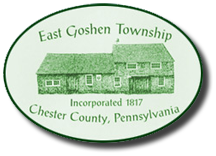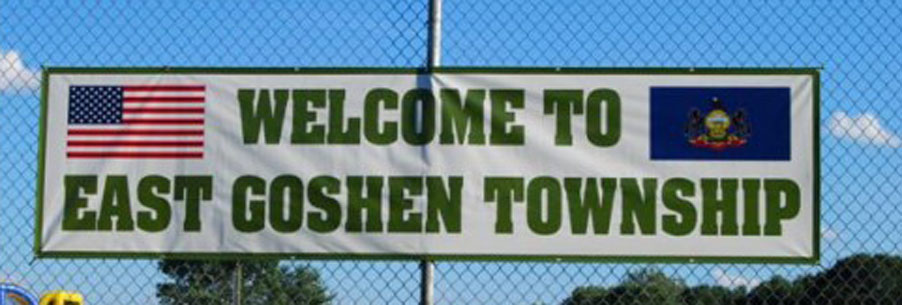About Us
Much of the charm of East Goshen Township comes from its historical heritage. The history and development patterns of the Township have defined, in part, current land use patterns, road systems, economics, points of interest and place names. Historic preservation has become an important element in the planning process because it ensures proper care of historic sites as well as an understanding of a community’s past, present and future.
Early History
East Goshen Township contains many historic resources that date back to when Europeans initially settled the area in the late 1600′s and in the early 1700′s. These resources have largely retained their historical integrity and greatly contribute to community character.
East Goshen Township was originally a part of a 5000-acre parcel of land known as the “Welsh Tract” and purchased from William Penn September 16, 1681. Early settlers conveyed the name Goshenville in the area but Goshen Township became the formally established municipality in 1704 encompassing West Chester and East and West Goshen Townships. Goshen Township was reduced in size with the incorporation of West Chester Borough in 1788 and the remaining Township was further divided into East Goshen and West Goshen Townships in 1817. Today, East Goshen Township comprises 10.1 square miles in area.
Many of the first settlers were Swedes and Dutch. These settlers created a fully self-sufficient agricultural community with the establishment of grist mills in the area of the village of Goshenville to grind their grain and the development of the Chester Road to take their produce to sell or trade. The first Quaker Meeting was built at the crossroads of Paoli Pike and Chester Road in 1702 which later became known as the village of Goshenville. The adjacent communities of Milltown, Rocky Hill, Hershey’s Mill and Dutton Mill were established around the grist mill operations in the township. By 1883, the township had three post offices in Goshenville, Milltown and Rocky Hill. Support retail operations such as blacksmiths and general stores emerged in the local communities.
Robert Williams is believed to have been the first settler in what is now East Goshen. It is said that he first lived in a cave. The exact site is unknown but is thought to be on what is now the south side of East Boot Road. In about 1702, Friends of Haverford contributed some 19 pounds for him to build a house. This house still stands on East Boot Road and is listed on the National Register of Historic Places. It is also thought that early Goshen Friends meetings were held in this house. The first Friends Meeting was built at the crossroads of Paoli Pike and North Chester Road in 1702.
The Welsh Quakers who settled in the area named their village Goshenville after Goshen in the Bible. Founded in 1704, Goshenville became a self-sufficient agricultural and spiritual community that supported their own Friends Meeting House, Grange, blacksmith ship, gristmill, sawmill, wheelwright shop, general store, post office and schoolhouse.
Revolutionary War
Goshenville played an important role in the Revolutionary War. On September 16, 1777, General Sir William Howe ordered Generals Cornwallis and Knyphausen with 10,000 British and Hessian soldiers to march to the upper fords on the Schuylkill River in order to cross and attack Philadelphia. The day before, General George Washington with 11,000 Continentals encamped near White Horse Tavern in Great Valley. Cornwallis’ British forces marched up North Chester Road to the Goshen Monthly Meeting located at the corner of Paoli Pike and North Chester Road arriving at about 9:00 a.m. Knyphausen with Howe marched to Turk’s Head (West Chester) where Howe split the force sending General Matthews’ British soldiers to Indian King Tavern and Knyphausen’s Hessians to meet up with Cornwallis’s force encamped at George Hoopes farm located just north of the Goshenville School. The Generals met at the Goshen Friends Meeting to discuss strategy and Howe ordered the Hessians to the Boot Tavern located at the intersection of Phoenixville Pike and Boot Road.
Washington, learning of the British advance, positioned his army along the ridge south of King Road. At about 1:00 p.m., Cornwallis pickets engaged Washington’s scouts just north of the encampment in what is known today as the southernmost part of Hershey’s Mill Village that runs along North Chester Road.
There were two skirmishes fought that day that collectively became known as the “Battle of the Clouds”. The first skirmish between the British First Light Infantry and units of the Pennsylvania Militia occurred at about 2:00 p.m. on the Thomas Rees farm north of Greenhill Road near North Chester Road. At nearly the same time, Knyphausen’s Hessians engaged more militia on the Meredith farm near the Boot Tavern. After the initial exchange of musket fire, the Pennsylvanians retired from the field.
The weather from all accounts was horrible. It was a cold, wet day with visibility ranging from a mist in the early morning to thick fog and frequent storms throughout the day. In the afternoon, a terrific downpour of rain began that halted further engagement. One German Jager called it the “heaviest downpour in the world”. Not only did the rain stop progress, it also dampened the gunpowder so no rifles or canon could be fired. Washington withdrew. If it had not rained in East Goshen on that afternoon, the war could have taken a different turn and the British might very well have won.
After providing each man with a “gill of rum”, Cornwallis and his troops proceed north in pursuit of the Continental Army’s General George Washington. Their objective was to capture General Washington and the remainder of his troops.
The encampment of George Hoopes’ farm contained approximately 13,00 cold, wet and exhausted soldiers including 486 wounded that had been injured at the Battle of the Brandywine five days earlier. The supply wagons carrying food, medicine and ammunition were three miles behind them and had to contend with muddy impassable roads. The likelihood of deaths occurring in this camp was high and a burial site would have been decided upon. The selection of that site would have been within sight of the encampment fur far enough away to prevent disease from affecting the camp. The preferred site would have been high and dry on the crest of a hill away from the water source and in an area that would have been easy to dig.
A Friends Meeting House was built of logs in 1709 the first in what is now called Chester County. A second Meeting House was built in 1849 due to a separation within the church ranks. Today the first one is used as the Goshen Friends School while the second one was bought by the Goshen Grange in 1920 after renting it for 26 years. Later it also became part of the Goshen Friends School.
In 1799 the Borough of West Chester was chartered and split off from Goshen Township. In 1817, Goshen Township was further divided into East and west Goshen Townships. By 1883, the Township had three post offices: Goshenville, Rocky Hill and Milltown.
Water-powered mills dotted the Township farmlands beginning in the late 17th Century. By the mid to late 18th Century there were four mills on Chester Creek and another eight on Ridley creek. These included grist, saw, cotton, woolen, cider and merchant mills.
Dating back to the Revolutionary War, the General Green Tavern and Hotel was located at Paoli Pike and Boot Road and was also used as a livestock market. During the Civil War troops often camped at and bought provisions from the General Green. It was torn down in 1960.
Development of Transportation Infrastructure
The primary transportation routes running through the Township included Paoli Pike, Boot Road and Chester Road. Paoli Pike served as the primary link between West Chester (originally known as Turk’s Head) and Paoli which further connected to points east. Boot Road provided the connection to agricultural communities north and west of the Township particularly near the areas of Exton and then on to Downingtown.
The first cars on the Philadelphia & West Chester Traction Company’s track carried officials on December 17, 1898. Regular service commenced January 4, 1899. It was followed by trolley service from 63rd street in Philadelphia to Newtown Square and then into West Chester beginning May 10, 1899.
At one time the Township even had its own airport! Sky Haven Airport was licensed in 1930 and was situated adjacent to the current Township Park on Paoli Pike.
East Goshen continued as a primarily agricultural community into the 1950′s. Today, the Township’s employment base is dominated by managerial and professional occupations as well as sales and technical operations. While the Township has changed from a rural agricultural area into a predominantly suburban living environment in the last 50 years, there remain many visible reminders of the original community’s roots. Historic features are scattered throughout the Township. These historic resources include Goshenville and Rocky Hill villages representing 18th and 19th Century structures and Milltown which presents a genre neighborhood for the mid 20th Century.
East Goshen Today
Today, East Goshen Township is a suburban community predominantly residential in nature but continues to be characterized by its historic rural landscape. It is approximately 10 square miles in size and has a total of 76.65 miles of roads in the Township. Of these, 60.01 miles are Township roads and 16.60 miles are State highways. The 1960′s marked the beginning of a period of rapid expansion through development. With 1,039 residents in 1950, the population has multiplied by fifteen to 16,824 in 2000 according to the U.S. Census.
East Goshen is a Township of the second class, governed by a board of five supervisors who are elected to six-year terms. The establishment of various committees, commissions and citizen groups has helped address local issues. These volunteer groups are extremely valuable and essential to the operation of the Township. The first Township Building was dedicated in 1970. It was replaced in 1993 with a newer and more spacious two-story building.
East Goshen Township is served by the Westtown-East Goshen Regional Police Department that was formed in December 1981. It is a full service law enforcement agency and provides police service to Westtown, East Goshen and Thornbury Townships. Overall, the Regional Police Department employs a total of 42 officers including nine part-time officers.
Goshen Fire Company was organized July 21, 1950 at a meeting of Guy Chillas, Fred LaChappelle, Herbert Schmitt, Tom Smith, Herbert Stafford and Joseph Supplee. Along with George Coffey, Ira Hicks and William Hoopes, they formed the first Board of Trustees.
The Township has two large parks (55 acres and 100 acres), several neighborhood parks and over 200 acres of open space. The Township has an established trail network through the Township Park located on both sides of Paoli Pike and connecting to the Plank House and Blacksmith Shop along East Boot Road.
Goshenville was designated a Historic District by the National Register of Historic Places in 2000. In addition to the houses in the district, there are also two “stand alone” houses also on the National Register: Goodwin Acres and the Robert Williams House. Other local historic districts include Rocky Hill (has eligibility for National Register status), Hershey’s Mill and Milltown. The Township passed its Historic Preservation Ordinance in 2003 then further enhanced and strengthened it by revision in 2006 including stricter guidelines for demolition as well as the expansion of adaptive re-use.
Although the community has changed significantly over the past few decades, the remaining historic sites and districts provide historical context to the Township’s character. How East Goshen Township continues to develop towards build-out and how it responds to future needs for redevelopment will form the framework for the future to protect our natural and historic resources, our transportation and community facilities and services for the next 100 years.



